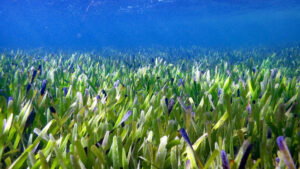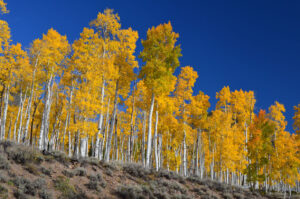
Plants that have rewritten the record books
By Daniel Austin
The kingdom of plants is a big one, each member is a standout and potential record holder if you dig deep enough. Even something as seemingly obvious as the world’s largest plant hasn’t been as straightforward as it might have seemed.
How did the world’s largest botanical organism remain unrecognised until as recently as 2022? Well, it turns out that lying beneath the ocean’s surface and requiring genetic confirmation of its clonal unity to achieve the gargantuan title has meant Posidonia australis from Shark Bay, Australia has existed largely in obscurity. This seagrass meadow is believed to be at least 4,500 years old and measures more than 180 square kilometres.
Moving from the record holder of the world’s largest plant to the world’s oldest, you will find another clonal giant in Pando, a massive clonal colony of quaking aspens (Populus tremuloides) in Utah’s Fishlake National Forest. There are, however, cases of ancient plants more extraordinary than that of the Pando. Cases of plants that have passed beyond the brink of extinction and have apparently disappeared from the planet for thousands of years, that is, aside from a skerrick of genetic material left behind in the form of ancient seed. While the siblings of these curios continued to breed and diversify, the genetic makeup of the ancient specimens remained unaltered, locked away, until by some twist of fortune, the dormant seed could be unearthed and resurrected. The stories of plants produced from such unlikely sources are truly remarkable indeed.

For several years, the oldest carbon-dated seeds to successfully germinate were those of a 1300-year-old Nelumbo nucifera Gaertn cv. Taizi, now known as the ‘Taizi Lotus’. These ancient seeds were discovered in 1984 in a dry pond deposit in suburban Beijing, China, and are thought to have come to be there, as a result of a grand garden reportedly at the location during the Ming dynasty. Soon after their discovery, the seeds were pre-treated with a concentrated sulphuric acid solution before being sown, and germination of reproductive offspring occurred as a result. Subsequent mapping of the plant’s genome found they displayed insufficient variation to modern Nelumbo nucifera to be deemed a different species, though studies have found several differences in their metabolic behaviour, compared to modern cultivars.
The record for the oldest viable seed was broken eleven years later when a two-thousand-year-old Judean date palm (Pheonix dactilifera), was successfully germinated in Israel. This seed was discovered during archaeological excavations at the Masada Fortress, where, among the ruins of King Herod’s palace, a jar was unearthed and therein lay a hidden store of ancient date seed. After two thousand years of anticipation, in 2005 after a hormone and nutrient treatment, germination was finally achieved by a singular seed.
Today the palm stands at over three metres and is named Methuselah, after a long-lived biblical figure. Upon reaching maturity the specimen proved to be male and produced pollen, which has sparked a new wave of research into phenology and breeding with extant Phoenix dactilifera. Closely related to an Egyptian cultivar of Pheonix dactilifera, the Judean date palm was, in earlier times, a major export crop but was considered extinct for over 1800 years.
It was Russian propagators though, that in 2013 surpassed all prior achievements in plant resurrection when scientists grew reproductive Silene stenophylla plants in culture, using the placental tissue of 32,000-year-old seeds unearthed from beneath Siberian permafrost. Immature seed containing viable tissue was found stockpiled among thousands of mature but damaged seeds in the warrens of ancient ground squirrels, some 38 metres deep in ice. Whilst the plants are virtually identical to extant examples, aside from a variation in petal shape, their internal biology may prove to be very different.
So what will be the next record to fall? Is there something bigger out there than Posidonia australis or older than Populus tremuloides?
Your guess is as good as mine but suffice to say, records are made to be broken…
Dan Austin
IPPS Member, Author
Lecturer, TAFE South Australia
M: 049 122 8591
E: daniel.austin@outlook.com
FB: BeyondGreenAustralia
W: ipps.org
Main image: The world’s largest plant is a sea grass Posidonia australis (Image: Rachel Austin, University of Western Australia)
